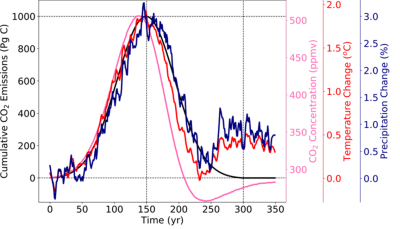Understanding the Coupled Carbon-Climate Response to Negative CO2 Emissions
Scientists use climate models to ask what would happen if humans were to change from emitting carbon into the atmosphere to removing it. This study finds that global warming remains roughly proportional to total carbon emissions over time, even as these total carbon emissions start to decrease because of the carbon removals. By looking at how different parts of the climate would respond to the carbon removals at different speeds, researchers find that it is possible that global warming would start to reverse even slightly before the switch from net emissions to net removals. Natural carbon sinks would switch to sources, but the climate would still start to cool because of the removals.
Climate scientists use two main metrics to create a remaining carbon budget for stabilizing the climate, which currently forms a key foundation of global climate policies. In short, these metrics represent the proportionality of global warming to total carbon emissions, and the remaining warming after reaching net zero emissions. We show that these same two metrics also work for predicting what would happen if we were to try to go beyond stabilizing the climate to restoring it by pulling carbon out of the atmosphere. This result shows that technologies to remove carbon from the atmosphere, if possible at large scales, may be effective at cooling the climate, even though doing so may also cause current carbon sinks to switch to sources.
We use both very complex and very simple climate models to explore the response of the climate system to carbon dioxide removals. Previous research had suggested that a metric of the proportionality between climate change and cumulative carbon dioxide emissions would not hold under net carbon removals. We show that the proportionality metric does hold even as cumulative carbon emissions start to decrease and that any deviation from that proportionality is well explained by a second metric of the remaining warming after reaching net zero emissions. Further, we find that the remaining warming after net zero emissions metric begins to influence the climate even before reaching net zero, so that metric also governs things like the relative timing of peak warming and the maximum warming. This experiment is useful in understanding the processes that govern each of these two metrics, and the timing and range over which each of these climate metrics are valid. These results will aid in understanding a wide range of climate mitigation strategies.


